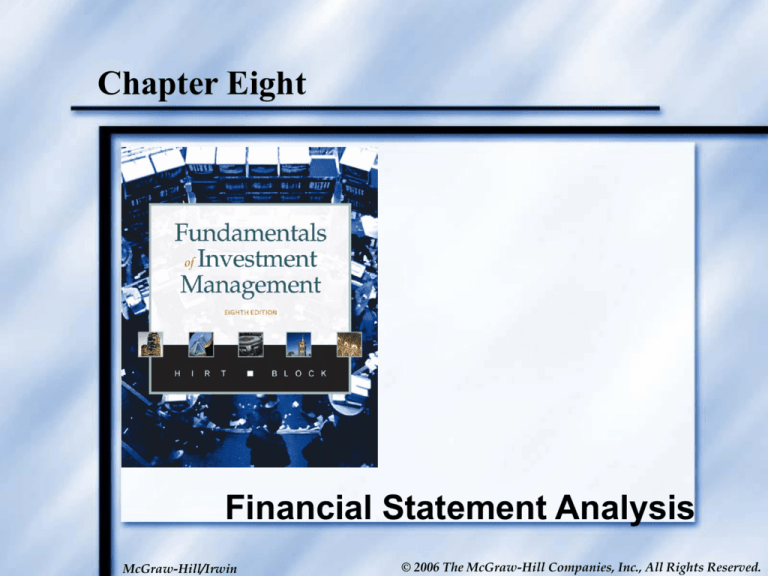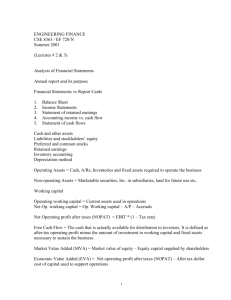
Chapter Eight
Financial Statement Analysis
1
McGraw-Hill/Irwin
© 2006 The McGraw-Hill Companies, Inc., All Rights Reserved.
The Major Financial Statements
Income Statement
Balance Sheet
Statement of Cash Flows
2
Income Statement
Device for measuring profitability of a firm
Defined period of time
•
•
•
•
One month
Three months
One year
Etc.
Continued
3
Income Statement
Presented in stairstep fashion
Shows profit after each
type of expense item
is deducted from revenues
4
Balance Sheet
Assets =
Liabilities
+
Owner’s Equity
5
Balance Sheet
What the firm owns
How assets are financed with
The firms
Holdings
and
Obligations
Continued
Liabilities
or
Ownership
Interest
6
Balance Sheet
End of calendar year, or
End of fiscal year
It is dated
Does NOT represent result of transactions
for a specific month, quarter, or year
Cumulative chronicle of all transactions
affecting the corporation since its inception
Generally, based on original cost basis
NOT current market value
7
Income Statement & Balance Sheet
ANSWER TWO QUESTIONS
Income
statement
Balance
Sheet
Shows
Shows
How much did the
firm make or lose
How much is
the firm worth
8
Statement of Cash Flows
Referred to in the
Statement of Financial Accounting (SFAS) No. 95
Replaced the
Old statement of changes in financial position
(and the source and uses of funds statement)
Continued
9
Statement of Cash Flows
Shows the critical nature of cash flow
to the operations of the firm
Represents
• Cash, or
• Cash-equivalent, e.g. money market fund
Continued
10
Statement of Cash Flows
Three primary sections:
1. Cash flows from operating activities
2. Cash flow from investing activities
3. Cash flow from financing activities
Above results added
together compute net
increase or decrease
in cash flow
11
Key Financial Ratios for the
Security Analyst
Ratio Analysis
Bankruptcy Studies
Classification System
12
Ratio Analysis
Operating
performance
Weigh &
Financial ratios
of a firm
Evaluate
Capital
structure
Continued
13
Ratio Analysis
Similar firms in
the industry
Compare firm’s
ratio results with
Own firm’s past
performance
14
Who might be, in particular,
interested in the ratios?
ANSWER:
All Stakeholders
Present and Prospective
15
Who might be, in particular,
interested in the ratios?
Investors
Managers
Lenders
Customers
Employees
Competitors
IRS (perhaps?)
16
Bankruptcy Studies
Ratio analysis
Protects
NOT
guaranteeing
picking
continual losers
picking
winners
17
Bankruptcy Studies
The Z (zeta) Score
Variables or ratios
1
Retained earnings
Total assets
What they can
indicate
Cumulative
Profitability
Earnings stability
Standard deviation of operating income
during the last 10
Total assets
2
years
Continued
Bankruptcy Studies
The Z (zeta) Score
Variables or ratios
Cont.
What they can
indicate
Earning before interest and taxes
3
Total assets
Productivity of
operating assets
Earning before interest and taxes
4
Interest
Leverage ratio,
interest coverage
5
Current assets
Current liabilitie s
Liquidity ratio
Continued
Bankruptcy Studies
The Z (zeta) Score
Variables or ratios
Market val ue of common stock
6
Book value of equity
7
Total assets
Cont.
What they can
indicate
Leverage ratio
Proxy for the
size of the firm
20
Classification System
20 Significant Ratios Divided Into
6 Primary Groupings
(Groups A through F)
21
Classification System
Group A – Profitability Ratios
1
Gross profit margin
2
After-tax profit margin
3
Return on assets
4
Return on equity (ROE)
Gross profit
Sales (revenue)
Net income
Sales
Net income
Total assets
Net income
Stockholde rs' equity
22
Return on Equity (ROE)
Dupont Analysis
Shows the relationship between
income statement & balance sheet
If ROE is unsatisfactory, the Du Pont
Analysis helps locate which part of the
business is underperforming
Age of assets must be considered
23
Return on Equity (ROE)
Dupont Analysis
Breaks down (ROE) into three parts:
RATIO
INDICATES/MEASURES
Profit margin
Operating efficiency
Total asset turnover Asset use efficiency
Financial leverage
Measured by the equity
multiplier
24
Classification System
Group B – Asset-utilization ratios
5
6
Receivables turnover
Sales
Receivable s
Inventory turnover
Sales
Inventory
7
Fixed-asset turnover
8
Total Asset turnover
Sales
Fixed assets
Sales
Total assets
25
Classification System
Group C – Liquidity Ratios
9
Current ratio
10
Quick ratio
11
Net working capital to
total assets
Current assets
Current liabilitie s
Current assets - Inventory
Current liabilitie s
Current assets - Current liabilitie s
Total assets
26
Classification System
Group D – Debt-utilization Ratios
12
13
14
15
Long-term debt to equity
Long - term debt
Stockholde rs' equity
Total debt to total assets
Total debt
Total assets
Income before interest & taxes
Interest
Times interest earned
Fixed charge coverage
Income before fixed charges & taxes
27
Interest
Classification System
Group E – Price Ratios
Price to earnings
(P/E ratio)
Common stock price
Earnings per share
17
Price to book value
Common stock price
Book value per share
18
Dividend to price
(dividend yield)
Dividends per share
Common stock price
16
28
Classification System
Group F – Other Ratios
19 Average tax rate
Income tax
Taxable income
20 Dividend payout
Dividends per share
Earnings per share
29
Uses of Ratios
Check the health of companies
Compare and analyze the 20 ratios
NOTE: Past growth rates are not a good
prediction of future growth rates
P/E ratio an indication of
• Financial risk
• Growth
• Profitability
30
Continued
Uses of Ratios
Cont.
One-year data doesn’t give direction of
company’s future performance
Long-term trend analysis focuses on
• Increasing/decreasing performance
• Volatility (riskiness) of the results
31
Comparing Long-Term Trends
Business cycle
Trend analysis
Long term performance
Growth rates (over 5 and 10 years)
Stable vs. volatile earnings
The stronger the financial condition the
lower the risk
32
Deficiencies of Financial Statements
Six areas that a financial analyst
should question
Inflation Effects
Inventory Valuation
Extraordinary Gains and Losses
Pension Fund Liabilities
Foreign Exchange Transactions
Other Distortions
33
Inflation Effects
Inflation has been mild in the last decade
Must be aware of potential effects of
inflation for the future
Inflation causes
• Phantom profit
• Profit may be as a result of increase in
prices (inflation) NOT satisfactory
performance
34
Continued
Inflation Effects
Cont.
Industries most sensitive to inflation-induced
profits:
•
•
•
•
Lumber (50% of profits due to inventory pricing)
Copper
Rubber
Food products
35
Inventory Valuation
Inventory valuation methods
• LIFO (last-in, first-out)
• FIFO (first-in, first-out)
In inflationary economy, profit increases
without increase in output
Inventory turnover appears higher in
LIFO than FIFO
36
Extraordinary Gains and Losses
Sale of corporate assets
Lawsuits
Inflate/deflate returns
Forecasting should include earnings
ONLY from continuing operations
Big impact on ratios
37
Pension Fund Liabilities
Increasing concern among financial analysts
Undefined liabilities of pension funds
Current obligations may have to come out
from future earnings
Penalize shareholders
Limit ability to reinvest in new assets
38
Foreign Exchange Transactions
Foreign currency fluctuations impact
earnings of companies doing
international trade
If US $
earnings from foreign
subsidiaries translate to more US $
39
Other Distortions
Detective work needed in accounting
methods (e.g. Enron)
R&D expenditures
Deferred taxes
Tax credits
Merger accounting
Intangible drilling
Development costs
Percentage depletion allowances
40
WEBSITE
COMMENTS
Provides detailed company
www.zacks.com
financial information and
ratios—mostly free.
Provides detailed financial
www.investor.reuters.com information, including ratios
and statements.
Provides financial
information and ratios for
www.morningstar.com
free, some information fee
based.
Provides investment
www.investors.com
related charts and tools.
41
WEBSITE
www.valueline.com
www.investopedia.com
www.ventureline.com
COMMENTS
Is a web version of print
information source.
Provides tutorials on
financial ratios.
Allows access to financial
ratios and other analytics,
requires registration for
access, and is fee based.
42
Summary
Basic accounting statements
• Income statement
• Balance sheet
• Statement of cash flows
Ratio analysis
Ratios can not help to find a gold mine
but can help avoid sick companies
20 ratios in 6 categories
43







